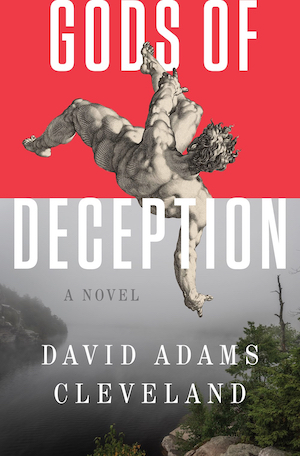If you read our thought-provoking interview with author David Adams Cleveland, you won’t be surprised that his new novel, Gods of Deception, is complex, layered and full of historical analysis. The book explores the 1950 trial of Alger Hiss – accused of spying for the Soviet Union – and how it affected the fascinating people involved.
In what was dubbed the trial of the century, Alger Hiss was convicted of two counts of perjury. People on the left widely believed Hiss was the victim of red-baiting, while conservatives were convinced he got off easy, and spying was his real game. Although Soviet documents declassified in the 1990s would seem to indicate Hiss was Moscow’s man, not all historians agree, even today.
These competing narratives put a real-life and consequential mystery at the heart of Cleveland’s book. Because Hiss managed to get himself attached to the US delegation to the Yalta conference near the end of World War II, he was certainly in a position to exert influence over its significant pro-Soviet outcomes. For example, Poland, Czechoslovakia, Hungary, Romania and Bulgaria fell behind the Iron Curtain and the Soviet Union gained swathes of Asia, with Mongolia split from China to become a Soviet satellite state.
The experience of reading Cleveland’s 917 pages is a bit like a visit to the optician. You believe you are seeing the picture clearly, but then some change, some slightly new way of looking is introduced, and the picture snaps out of focus again. Cleveland goes over the same ground repeatedly, though from slightly different points of view. With so much going on, the repetition is mostly helpful.
Central to the fictional story, which takes place in 2002, is the widowed Judge Edward Dimock, who served on Hiss’s defence team 52 years earlier. Dimock, who once clerked for Oliver Wendell Holmes (the year after Hiss held that position), has had a long and illustrious career. In his 90s now, the judge has asked his grandson George Altmann to take charge of his memoirs. George is an astrophysics professor who’s abandoned academia to run a struggling Manhattan art gallery.
The Hiss case was pivotal in Dimock’s career and a source of serious family conflict. For different reasons, his wife, his oldest son (killed in Korea), and daughter Alice hated his participation. Key to the defence strategy was an effort to destroy the reputation of Hiss’s chief accuser, Whittaker Chambers, by painting him as a psychopath. This ploy didn’t succeed and at a personal level pitted Dimock against his second daughter, a psychotherapist.
Only the Judge’s youngest daughter, Cordelia, George’s mother, escaped the Hiss-related rancour. Living in Woodstock, she was a lively child of the 60s, knew many well-known musicians, and married a rock concert technician. The technician’s father was a noted artist, fallen out of popular favour and reduced to making courtroom sketches.
Among his grandfather’s papers, George finds a set of nine pencil sketches drawn by his paternal grandfather that portray a set of colleagues later found to be Soviet spies. Prominent in the group are Alger Hiss and his wife Priscilla. All Hiss’s denials appear to be lies. If the Dimock was aware of these associations before the trial, why didn’t he share this information with the prosecution, as he is required to do?
The men in the drawings were all potential witnesses against Hiss. Five of them died mysteriously or left the country permanently before they could testify. Another was murdered in prison days before Hiss’s release. The last was unidentified. George’s artist grandfather, presumed to be a suicide, is another possible victim.
The Dimocks’ idyllic family home in the Catskill Mountains, called The Hermitage, is the setting for many of the family’s interactions. Stuffed with memories, the house and surrounding country have achieved near-mythic status in family members’ minds. Most notable is the great room’s 16th century ceiling, formed by the keel of a ship that displays frolicking gods and goddesses – of deception and otherwise.
Two other themes are woven throughout the novel. George’s studies of astrophysics have acquainted him with the theory of parallel universes, and it seems to him the judge is a living example, given his ability to hold two contradictory realities in mind. There’s also a strong streak of creativity in the Dimock family. The Judge Dimock’s wife, Annie, was a concert pianist and subjected her children and grandchildren to vigorous practicing, with varying success. Cordelia was a talented ballerina until an injury ended her career.
George’s girlfriend, Wendy Bradley, also figures prominently in the story. She’s an artist and a skilled rock climber. She combines these two loves in her paintings, in which she depicts herself nude, scaling rock-faces. Though Wendy helps plan and implement George’s quest for the truth of the judge’s memoir, I never warmed up to her. She’s manipulative and seemed to have a hidden agenda, much too interested in the unravelling of the story’s mysteries. By contrast, George’s parents, aunts and cousins are all well drawn.
Ultimately, one message of the book is that the Hisses of the world, determined liars and true believers, can create a climate of disinformation, a parallel reality it’s hard to break free of. Their concoctions can lead even the most intelligent people astray and down paths of likely destruction. This is certainly a message that should resonate in today’s world. Although reading such a hefty book may feel like a daunting prospect, rest assured that Gods of Deception well rewards its readers at many levels.
Also see Rory Clements’s A Prince and a Spy, Tom Bradby’s Yesterday’s Spy, and Appointment in Tehran by James Stejskal.
Greenleaf Book Group
Print/Kindle
£7.79
CFL Rating: 5 Stars
